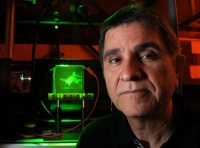’We can record a three-dimensional image in one location and show it in another location, in real time, anywhere in the world,’ said Nasser Peyghambarian, who led the research effort.
Holographic stereography has been capable of providing large-scale 3D static images with excellent resolution and depth reproduction, but has been missing the capability to be dynamically updated until now, according to the researchers.
’At the heart of the system is a screen made from a novel photorefractive material, capable of refreshing holograms every two seconds, making it the first to achieve a speed that can be described as quasi real time,’ said Pierre-Alexandre Blanche, an assistant research professor in the University of Arizona’s College of Optical Sciences.
The prototype device uses a 10in screen, but Peyghambarian’s group is already successfully testing a much larger version with a 17in screen.
The image is recorded using an array of regular cameras, each of which views the object from a different perspective. That information is then encoded onto a fast-pulsed laser beam, which interferes with another beam that serves as a reference. The resulting interference pattern is written into the photorefractive polymer, creating and storing the image. Each laser pulse records an individual holographic pixel in the polymer.
The hologram fades away by natural dark decay or it can be erased by recording a new 3D image, creating a new diffraction structure and deleting the old pattern.
One of the system’s major hallmarks never achieved before is what Peyghambarian’s group calls full parallax. ’As you move your head left and right or up and down, you see different perspectives. This makes for a very lifelike image,’ he said.
The work is a result of a collaboration between the University of Arizona and Nitto Denko Technical, or NDT, a company in Oceanside, California, which provided the photorefractive polymer sample.
Currently, the system can display one colour only, but Peyghambarian and his team have already demonstrated multi-colour 3D display devices capable of writing images at a faster refresh rate, approaching the smooth transitions of images on a TV screen.

Nasser Peyghambarian with a refreshable, holographic image of an F-4 Phantom Jet created on a photorefractive polymer at the University of Arizona’s College of Optical Sciences





Nanogenerator consumes CO2 to generate electricity
Whoopee, they've solved how to keep a light on but not a lot else.